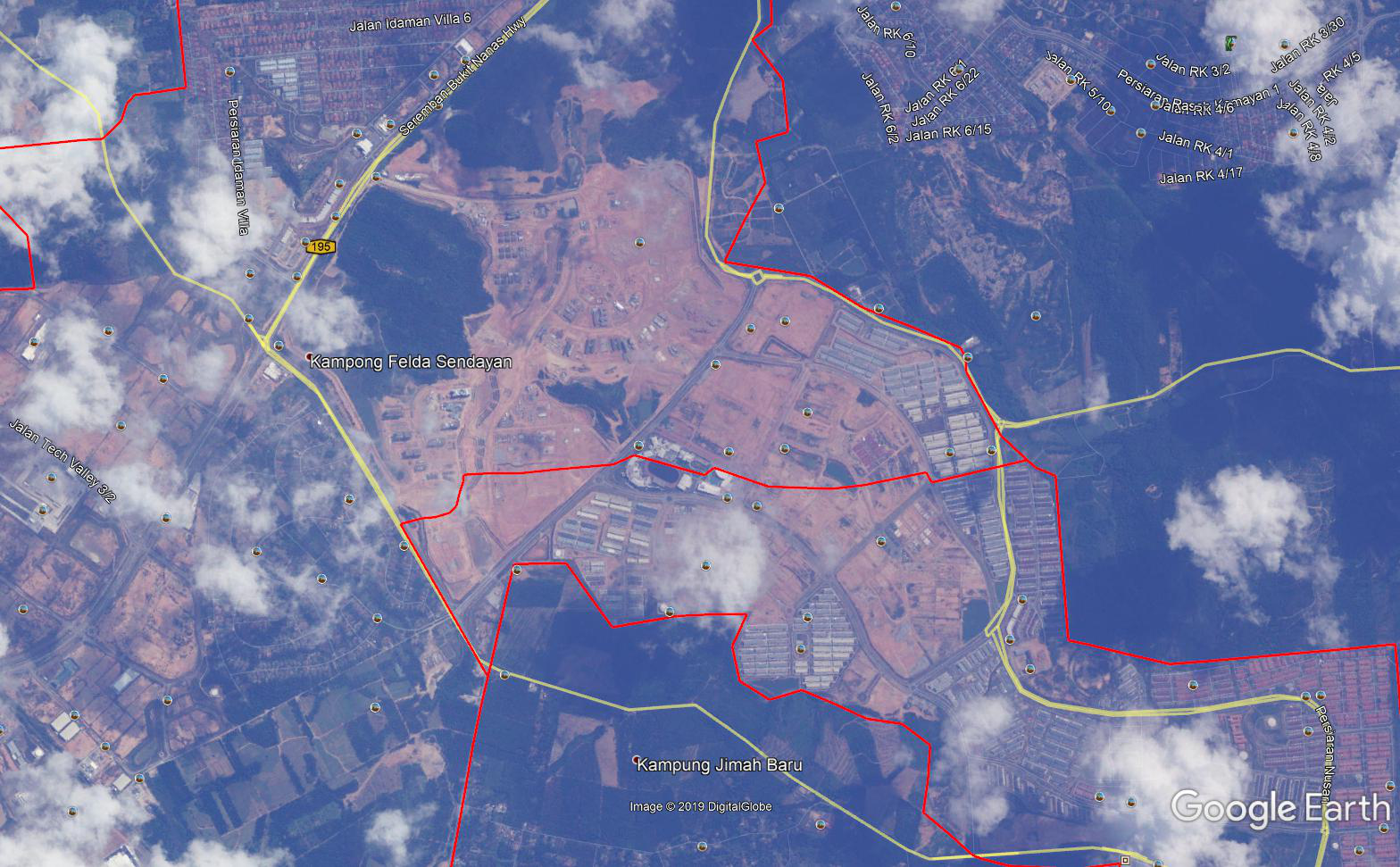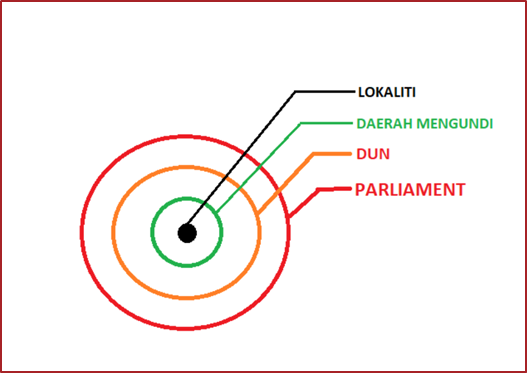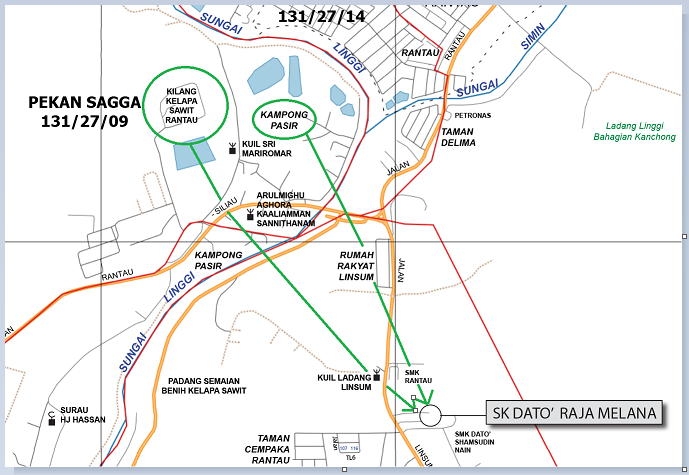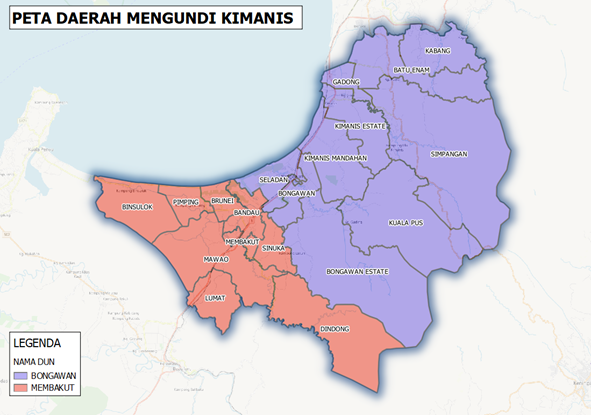(WORK IN PROGRESS)
* Want to know more – email us at info@tindakmalaysia.com/ Mahu maklumat lanjut – sila emel pihak kami melalui info@tindakmalaysia.com
This section covers our new research areas in the Redelineation World. Before GE14, we explored redelineation at the national and state level. Our BERES and Tindak Malaysia 2014 Forum Proposals have been submitted to the Institutional Reform Committee (IRC)- May 2018, Electoral Reform Committee (ERC) – March 2019 and EC – from late 2018. However, we came to a conclusion that the redelineation can only be fixed if the voters are assigned correctly in the geographic manner and micro divisions (polling districts) are drawn in meaningful sense. Below here are the specific research examples that we have proposed to EC since late 2018
Bahagian ini meliputi kawasan penyelidikan baru kami dalam seksyen Pensempadanan. Sebelum PRU14, pihak kami mengkaji pensempadanan pada peringkat negara dan negeri. Cadangan kami dalam Projek Beres dan Forum Tindak Malaysia 2014 telah dikaji oleh Jawatankuasa Pembaharuan Institusi (IRC) – Mei 2018, Jawatankuasa Pembaharuan Pilihan Raya (ERC) – Mac 2019 dan Suruhanjaya Pilihan Raya (SPR) – dari akhir 2018. Akan tetapi, kita berpendapat baru – baru ini bahawa pensempadanan hanya boleh diperbaiki apabila pemilih – pemilih telah diagihkan ke tempat yang betul and daerah mengundi mempunyai bentuk yang bermakna. Berikut adalah contoh – contoh kajian kami yang terperinci dan kandungan kajian kami telah dihantar kepada SPR sejak akhir tahun 2018
The diagram below shows the relationship between a locality, polling district, state constituency (DUN) and parliamentary constituency. Every elector is assigned either to a geographical (Housing estate, village, Flat Block) or non-geographical locality (Absent Voter, Former Military, Former Police). The diagram is based on EC’s description
Gambar rajah di bawah menunjukkan hubungan antara lokaliti, daerah mengundi, kawasan pilihan raya negeri (DUN) dan kawasan pilihan raya parlimen. Setiap pemilih diagihkan kepada lokaliti mengikut geografi (Taman, Kampung, Blok Flat) atau lokaliti bukan geografi (Pengundi Tidak Hadir, Bekas Tentera, Bekas Polis). Gambar rajah ini mengikut penjelasan SPR
The shape and population size of polling districts will ultimately impact the geographical representation and the fairness of redelineation process. Multiple polling districts forms a DUN and two or more DUNs more form a parliamentary seat. Hence, the effect of polling districts should not be underestimated
Bentuk dan bilangan pemilih untuk daerah mengundi akan memberi kesan kepada representasi geografi dan keadilan dalam proses pensempadanan. Beberapa daerah mengundi akan membentuk satu DUN dan dua DUN atau lebih akan membentuk satu kawasan pilihan raya Parlimen. Oleh itu, impak daerah mengundi tidak boleh diperkecilkan
**All maps are designed by Tindak Malaysia. Please cite SPR and Tindak Malaysia when reproducing them/ Kesemua peta telah direka oleh Tindak Malaysia. Sila nyatakan nama sumber ‘SPR dan Tindak Malaysia’ apabila peta dicetak semula**
1) SEMENYIH: GOOD AND BAD EXAMPLES OF POLLING DISTRICTS/ SEMENYIH: CONTOH DAERAH MENGUNDI BAIK DAN BURUK
GOOD EXAMPLE: BUKIT MAHKOTA POLLING DISTRICT/ CONTOH BAIK: DAERAH MENGUNDI BUKIT MAHKOTA

We, Tindak Malaysia, would like to commend EC for opening an additional polling station in the largest polling district (in terms of population) in Semenyih for the by election.By assessing the allocation of voters to the polling stations (refer to the map of localities as above), this is a very good case of ensuring voters have easy access to vote. Localities are colour coded based on polling stations and one can see how this allocation at this polling district worked out well.
Kami, pihak Tindak Malaysia, memuji tindakan SPR untuk membuka pusat mengundi baru untuk daerah mengundi yang terbesar (dari segi bilangan pemilih) di Semenyih untuk pilihan raya kecil (PRK). Dengan menilai pengagihan pemilih ke tempat mengundi (sila rujuk kepada peta lokaliti di atas), situasi ini merupakan contoh yang baik yang menunjukkan pemilih boleh datang ke pusat mengundi dan melaksanakan tanggungjawab mereka dengan senang. Setiap lokaliti telah diwarnai mengikut pengagihan pusat mengundi. Anda sendiri akan sedar pengagihan di Bukit Mahkota adalah amat baik
BAD EXAMPLE: DOWNTOWN SEMENYIH/ CONTOH BURUK: PUSAT PEKAN SEMENYIH

*Refer to the map above/ Sila rujuk kepada peta di atas
The polling station for Semenyih Indah Polling District is located in Kampung Baharu Semenyih Polling District. The polling station for Kampung Baharu Semenyih is located in Pekan Semenyih Polling District. The polling district of Pekan Semenyih has three polling stations (one for itself, one for Kampung Tanjung and another for Kampung Baharu Semenyih). The very location of polling station for Kampung Baharu Semenyih in Pekan Semenyih district may cause traffic jams. Fortunately, the traffic situation wasn’t bad as the turnout wasn’t high as GE14.
Pusat Mengundi untuk Daerah Mengundi Semenyih Indah terletak di Daerah Mengundi Kampung Baharu Semenyih. Pusat Mengundi untuk Daerah Mengundi Kampung Baharu Semenyih terletak di Daerah Mengundi Pekan Semenyih. Daerah Mengundi Pekan Semenyih mempunyai tiga pusat mengundi (satu untuk daerah mengundi tersebut, satu untuk Kampung Tanjung dan satu lagi untuk Kampung Baharu Semenyih). Lokasi pusat pengundian untuk Kampung Baharu Semenyih yang terletak di Pekan Semenyih mungkin mengakibatkan kesesakan jalan di Pekan Semenyih. Namun begitu, situasi tidak jadi buruk kerana peratusan pengundian masih bawah tahap PRU14
2) RANTAU: FIXING POLLING DISTRICTS AND LOCALITIES/ RANTAU: PEMBAIKAN UNTUK DAERAH MENGUNDI DAN LOKALITI
- Polling District Boundaries of Sendayan (Left hand side)and Kampong Sendayan (Lower right side) arbitrarily cutting across future housing estates
Polling district boundaries ought to be drawn which respects neighbourhood boundaries, new development areas or any relevant boundaries. In our proposal to Selangor and Penang State governments (2015), we even recommend that no polling district boundary should be straddling over two local authority areas. The 2016 polling district redivision exercise (which changes boundaries of polling district) failed to take account of the pace of development going in Rantau. Let us point to this example in the map above between the boundary of Sendayan and Kampong Sendayan. After GE13, these two areas are experiencing fast paced development on what used to be oil palm estate territories. Based on publicly available images that EC has placed on media, one can see the red line is crossing the new development area (basing on the Google image as of 2015 – prior to the redivision exercise). Was the EC staff made aware of the developments of Sendayan? The red line cutting across the area will create arbitrary splitting communities of common area into two territories. This can cause of unnecessary inconveniences to voters when they get assigned to polling stations that may be quite far from them
**EC has acknowledged some of the localities – polling district association weren’t correct and they are making the fixes accordingly**
We would like to highlight examples in Rantau where there are mismatches in the locality assignment to the polling district
To illustrate our point, Rumah Rakyat Linsum is a locality. When it is mapped on Google Maps and overlayed with Polling District Boundaries of Linsum, Rumah Rakyat Linsum is firmly within Linsum. They are rightfully assigned to the SK Dato’ Raja Melana (like all other voters in Linsum). This is a correct association.
Examples of inconsistencies in Linsum (refer to the map above):
1) Rantau Palm Oil Factory (Kilang Kelapa Sawit Rantau). If you overlay the Linsum polling district boundaries in reality, there is not a single palm oil factory found in Linsum. It requires a bit of research to find this original factory (one source states here – https://foursquare.com/v/kilang-kelapa-sawit-rantau/4d40ef46cb84b60cc6d78aab) and it was found in Pekan Sagga polling district. 94 voters were affected
2) Kampong Pasir, physically straddling between Pekan Sagga and Kampong Siliau voting districts, is associated with Linsum Polling District. 510 voters were affected
In both instances, this type of inconsistency somehow benefited the voters as their assigned polling centre is quite near
Other inconsistencies:
Taman Marlin Heights (associated with Taman Kelab Tuanku polling district). Geographically, it is in Angsa Emas polling district and very close to the polling station of Kampong Mambau. However, due to the mismatch in locality assignment, the voters had to travel far to cast their ballots : 29 voters affected
Kampung Ribu (associated with Kuala Sawah polling district). Likely, it is geographically in Kampong Sri Lalang polling district (Referred location site: https://www.iproperty.com.my/property/rantau/rent-4702965/): 80 voters were affected
Kampung Sagga Baru (associated with Pekan Sagga polling district). It is geographically in Kampung Siliau polling district. Voters are fortunate to vote closer with the Pekan Sagga residents. 248 voters were affected
For Rantau polling district, it has the following localities located in another polling district yet associated with Rantau polling district. Ths localities are:
- Kampung Rantau: 151 voters were affected
- Kampung Tanjong: 211 voters were affected
- Kampung Kanchong: 375 voters were affected
- Taman Chempaka: 139 voters (they are located in Linsum. The voting centre for Linsum is right in front of them (Refer to the map above)
- Taman Sri Permata (Worst example). Physically located outside of DUN (next to Kuala Sawah). 49 voters were affected. They are required to travel 6 to 7 km to Rantau to vote
3) KIMANIS: A CASE OF REDRAWING OF POLLING DISTRICTS/ KIMANIS: SATU KES UNTUK MENGUBAH DAERAH MENGUNDI
KAJIAN DAERAH MENGUNDI KIMANIS_TINDAK_MALAYSIA_28012020
Tindak Malaysia’s team decided to investigate the issues of existing Kimanis districts that were demarcated in 2016 and proposed solutions for EC. The basis of the reworking of the polling districts as follows:
- Localities must reflect correct names
- Localities must be assigned to polling districts based on the correct locations
- Polling district boundaries must respect local authority boundaries
- Polling district boundaries must be drawn to allow voters to vote at the nearest polling station
- Polling district boundaries should have acceptable population sizes
The above report (in Malay only) examines how Kimanis polling districts ought to be redrawn
Pihak Tindak Malaysia telah mengkaji isu – isu dengan pembentukan daerah mengundi Kimanis yang asalnya dipersempadankan sewaktu 2016 dan pihak kami membentangkan cadangan – cadangan kami kepada SPR. Prinsip – prinsip untuk pensempadanan semula untuk daerah mengundi ialah:
- Lokaliti perlu mempunyai nama yang betul
- Lokaliti perlu diagihkan mengikut daerah mengundi berdasarkan kedudukan yang betul
- Sempadan daerah mengundi perlu menghormati sempadan Pihak Berkuasa Tempatan
- Sempadan daerah mengundi perlu direka untuk memastikan pemilih boleh mengundi di tempat mengundi yang dekat
- Sempadan daerah mengundi perlu mempunyai bilangan pemilih yang munasabah
Laporan di atas (hanya dalam Bahasa Malaysia) mengkaji bagaimana daerah mengundi di Kimanis patut dipersempadankan semula
4) CRITICISMS OF 2019 SABAH REDELINEATION REPORT/ KRITIKAN TERHADAP LAPORAN PENSEMPADANAN SEMULA SABAH 2019
Sabah’s 13 New Seats: Unfortunate exercise amidst electoral changes (Statement on 15/7/2019)
Tindak Malaysia expresses concern on the potential approval of 13 new state (DUN) constituencies and the subsequent redelineation of the surrounding seats in Sabah. This exercise not only violates the Pakatan’s manifesto of rectifying malapportionment but is also a wasteful exercise for EC to implement. The tabling of the bill and subsequent approval may signal to Malaysians that PH is willing to accept and implement the existing constitutional loopholes to gazette an unfair exercise.
- The constitutional loophole which allowed EC not to abide by the principles of 13th schedule (such as checks on malapportionment and gerrymandering) transpired in this redelineation exercise whereby 5 undersized state constituencies will be created. Shockingly, the two rounds of recommendation did not make any attempt to increase the population size of those 5 proposed constituencies to be closer to state electoral quota (i.e. state average)
- Tindak Malaysia’s research found there was a compounding effect of 13 new seats on voter’s value across the state. Tindak Malaysia proposes the maximum deviation from the state electoral quota for Sabah is +/-25% The creation of 13 new constituencies resulted the following (based on two rounds of recommendations):
- 2 existing constituencies surrounding those new seats will become grossly undersized (More than – 25% (negative) from Electoral Quota)
- Around 8 constituencies (which is currently overpopulated) experience further erosion of voter value (More than + 25% above from the electoral quota)
- The disparity between urban and rural constituencies (at the DUN level) becomes starker thanks to the proposal of 13 new constituencies. Voters in urbanized areas around Kota Kinabalu, Sandakan and Tawau will see the voting value significantly slashed
- Sabah becomes one of the blatant cases of electoral unfairness in Malaysia when it comes to disparity of urban-rural voter value
- The potential malapportionment in Sabah as stated above will be further exacerbated by two future factors: Lowering of voting age to 18 and automatic voter registration. Estimated 23% of the Sabah’s population of the age above 21 are unregistered (EC 2019 Statistics). Additional voters coming from the age bracket of 18 – 21 may raise the voting population by 8% (Tindak’s 2019 estimate). Such expansions do not do any favour for any of the overpopulated DUNs after 13 seats are gazetted
- Moreover, one of the proposed state constituencies (Segama) straddles over two council areas. 15 existing state constituencies were found straddling over two council areas. There was no attempt in two rounds of recommendation to synchronize these boundaries
- The creation of 13 new seats does not alter the nature of overpopulated DUNs that are held by PKR and DAP. While the original equation of 13 seats may have granted free pass for BN, the current dynamic of 13 seats favours parties that may have stronger bases for certain areas such as Warisan and UPKO. It is of our concern whether the finalised 13 seats may be biased to certain parties
- Throughout the exercise, the voters were not made aware of the effect of the proposed recommendations
- We are absolutely in concurrence with Bersih that the 2017 proposal undermines One Person One Vote One Value (OPOVOV)

- We support Bersih’s call that the bill should be withdrawn due to ever changing circumstances in new Malaysia
- Should the bill be formally tabled on Wednesday, we urge all MPs across the board to reject the proposal. This will force a situation where the PM may have to consult EC to do amendments
- This could present an opportunity for the bill to be withdrawn where possible.
- Alternatively, we appeal to the reformed EC to amend the boundaries of 13 new constituencies to comply with two key principles of 13th schedule (reducing malapportionment and synchronizing boundaries with district boundaries)
- Within this constraint, MPs can approve flawed but slightly fairer boundaries for Sabah
- We call upon Sabah State Assembly and Parliament of Malaysia to table the following proposals in the future:
- Parliament of Malaysia to amend the total nationwide number of parliamentary representations per state. For Sabah and Labuan, we propose 26 parliamentary seats only whereby Sabah will have 25 seats (as opposed to 26 now within Sabah)
- Sabah State Assembly ought to increase total number of DUNs from 73 to 75. We believe total number of representations of the state assembly should be a multiple of the total number of federal seats. Both current and proposed situation resulted in some parliament seats have 2 constituencies while others have 3. This will help to ameliorate the situation of gross voter value disparity both at parliamentary and DUN level
- Parliament of Malaysia to amend the constitution to tighten constitutional principles pertaining to the redelineation. This includes reinstatement of electoral quota definition, time limit for PM to tables EC’s report to Parliament and closing constitutional loopholes that permit electoral boundary abuses for new seats
- We call upon Parliament of Malaysia to form a separate Boundaries Commission to review all future redelineation exercise and respect the independence of this commission to perform redelineation duties.
- With a separate Boundary Commission and strong constitutional principles, it is possible to ensure fair boundaries for voters in Sabah
We, Tindak Malaysia, still remains concerned about the prospect of the bill being tabled which will undermine fairness for Sabah (as they have experienced rigged boundaries in 1994 which curtailed capability of certain political parties). Similar to the call of automatic voter registration (which is silent on the verification of address), the tabling of the bill demonstrated that failure of Pakatan Harapan government of formulation of thorough amendments to upgrade and enhance electoral fairness of all. We perceive this exercise as an unnecessary stumbling block in the electoral reform process and call upon all MPs to reject the 2017 proposal in the first round. We call upon MPs to consult with various electoral NGOs and Electoral Reform Committee on the best way forward for Sabah.






